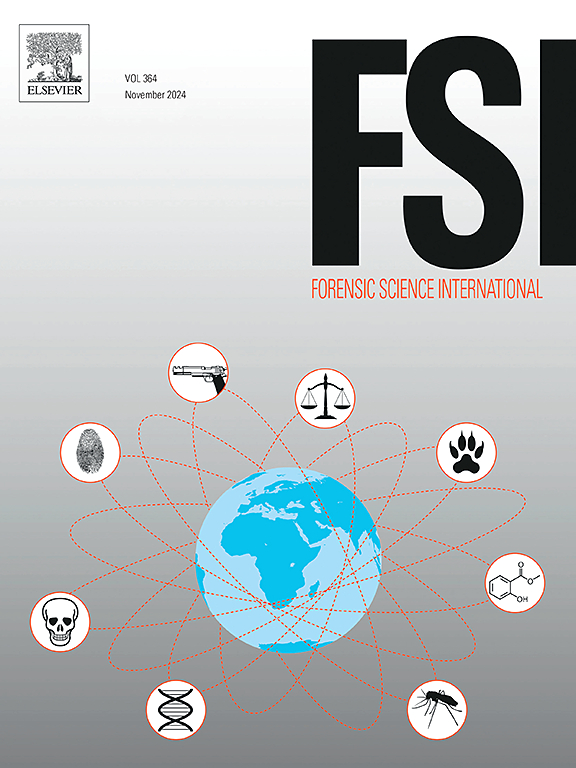Do machine learning methods solve the main pitfall of linear regression in dental age estimation?
IF 2.2
3区 医学
Q1 MEDICINE, LEGAL
引用次数: 0
Abstract
Introduction
Age estimation is crucial in forensic and anthropological fields. Teeth, are valued for their resilience to environmental factors and their preservation over time, making them essential for age estimation when other skeletal remains deteriorate. Recently, Machine Learning algorithms have been used in age estimation, demonstrating high levels of accuracy. However, their precision with respect to the trend of age estimation error, typical in some traditional methods like linear regression, has not been thoroughly investigated.
Aim
To evaluate and compare the performance of frequently used Machine Learning-assisted methods against two traditional age estimation methods, linear regression and the Segmented Normal Bayesian Calibration model.
Methods
Overall, 1.949 orthopantomographs from black and white South African children aged 5–14 years, with 49 % males, were evaluated. The performance of Random Forest, Support Vector Regression, K-Nearest Neighbors and the Gradient Boosting Method were compared against traditional linear regression and the Segmented Normal Bayesian Calibration model. The comparison was based on accuracy measures, including Mean Absolute Error and Root Mean Squared Error, and precision measures, including the Inter-Quartile Range of the error distribution and the slope of the estimated age error relative to chronological age.
Results
The Machine Learning methods outperformed linear regression and the Segmented Normal Bayesian Calibration models in terms of accuracy, although the differences were small. Gradient Boosting Method and Support Vector Regression achieved the highest levels of accuracy (Mean Absolute Error: 0.69 years, Root Mean Squared Error: 0.85 years). All Machine Learning methods and linear regression exhibited significant bias in residuals, whereas the Segmented Normal Bayesian Calibration model showed no significant bias. Gender-stratified analyses revealed similar results in terms of the accuracy and precision of all considered models.
Conclusion
Although Machine Learning methods demonstrate high levels of accuracy, they may be prone to trends in error distribution when estimating dental age. Evaluating this error is crucial and should be an integral part of model performance evaluation. Future research should aim to improve accuracy while rigorously addressing systematic biases.
机器学习方法是否解决了牙齿年龄估计中线性回归的主要缺陷?
年龄估计在法医和人类学领域是至关重要的。牙齿因其对环境因素的适应能力和随时间的保存能力而受到重视,因此当其他骨骼残骸恶化时,牙齿对年龄估计至关重要。最近,机器学习算法被用于年龄估计,显示出很高的准确性。然而,它们的精度相对于年龄估计误差的趋势,在一些传统的方法,如线性回归,尚未深入研究。目的:评估和比较常用的机器学习辅助方法与两种传统年龄估计方法(线性回归和分段正态贝叶斯校准模型)的性能。方法:对来自南非5-14岁黑人和白人儿童的1.949张骨科断层扫描照片进行评估,其中49例 %为男性。比较了随机森林、支持向量回归、k近邻和梯度增强方法与传统线性回归和分段正态贝叶斯校准模型的性能。比较的依据是准确性指标,包括平均绝对误差和均方根误差,以及精度指标,包括误差分布的四分位数范围和估计年龄误差相对于实际年龄的斜率。结果:机器学习方法在准确性方面优于线性回归和分段正态贝叶斯校准模型,尽管差异很小。梯度增强法和支持向量回归达到了最高的精度水平(平均绝对误差:0.69年,均方根误差:0.85年)。所有的机器学习方法和线性回归在残差上都有显著的偏差,而分割正态贝叶斯校准模型没有显著的偏差。性别分层分析显示,在所有考虑的模型的准确性和精度方面,结果相似。结论:虽然机器学习方法具有较高的准确性,但在估计牙龄时容易出现误差分布的趋势。评估这种误差是至关重要的,应该是模型性能评估的一个组成部分。未来的研究应致力于提高准确性,同时严格解决系统性偏差。
本文章由计算机程序翻译,如有差异,请以英文原文为准。
求助全文
约1分钟内获得全文
求助全文
来源期刊

Forensic science international
医学-医学:法
CiteScore
5.00
自引率
9.10%
发文量
285
审稿时长
49 days
期刊介绍:
Forensic Science International is the flagship journal in the prestigious Forensic Science International family, publishing the most innovative, cutting-edge, and influential contributions across the forensic sciences. Fields include: forensic pathology and histochemistry, chemistry, biochemistry and toxicology, biology, serology, odontology, psychiatry, anthropology, digital forensics, the physical sciences, firearms, and document examination, as well as investigations of value to public health in its broadest sense, and the important marginal area where science and medicine interact with the law.
The journal publishes:
Case Reports
Commentaries
Letters to the Editor
Original Research Papers (Regular Papers)
Rapid Communications
Review Articles
Technical Notes.
 求助内容:
求助内容: 应助结果提醒方式:
应助结果提醒方式:


